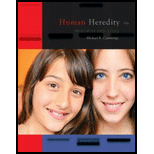
To determine: The legal and ethical issues that surround the use of IVF.
Introduction: The in vitro fertilization (IVF) is one of the most successful methods of assisted reproductive technology (ART) that has resulted in the birth of millions of children worldwide. This process involves collection of eggs which are then placed in a petridish and the sperms are added to the dish to facilitate the process of fertilization. The newly formed zygote is placed in an incubator for embryonic development and is finally implanted into the uterus of female partner for development.
To determine: The possible methods that can resolve the legal and ethical issues associated with IVF.
Introduction: The in vitro fertilization (IVF) is one of the most successful methods of assisted reproductive technology (ART) that has resulted in the birth of millions of children worldwide. This process involves collection of eggs which are then placed in a petridish and the sperms are added to the dish to facilitate the process of fertilization. The newly formed zygote is placed in an incubator for embryonic development and is finally implanted into the uterus of female partner for development.
To determine: The reasonable fate of the extra gametes that are removed from the woman’s body but never implanted in the uterus.
Introduction: The in vitro fertilization (IVF) is one of the most successful methods of assisted reproductive technology (ART) that has resulted in the birth of millions of children worldwide. This process involves collection of eggs which are then placed in a petridish and the sperms are added to the dish to facilitate the process of fertilization. The newly formed zygote is placed in an incubator for embryonic development and is finally implanted into the uterus of female partner for development.
Want to see the full answer?
Check out a sample textbook solution
Chapter 16 Solutions
Human Heredity: Principles and Issues (MindTap Course List)
- please fill in the empty sports, thank you!arrow_forwardIn one paragraph show how atoms and they're structure are related to the structure of dna and proteins. Talk about what atoms are. what they're made of, why chemical bonding is important to DNA?arrow_forwardWhat are the structure and properties of atoms and chemical bonds (especially how they relate to DNA and proteins).arrow_forward
- The Sentinel Cell: Nature’s Answer to Cancer?arrow_forwardMolecular Biology Question You are working to characterize a novel protein in mice. Analysis shows that high levels of the primary transcript that codes for this protein are found in tissue from the brain, muscle, liver, and pancreas. However, an antibody that recognizes the C-terminal portion of the protein indicates that the protein is present in brain, muscle, and liver, but not in the pancreas. What is the most likely explanation for this result?arrow_forwardMolecular Biology Explain/discuss how “slow stop” and “quick/fast stop” mutants wereused to identify different protein involved in DNA replication in E. coli.arrow_forward
- Molecular Biology Question A gene that codes for a protein was removed from a eukaryotic cell and inserted into a prokaryotic cell. Although the gene was successfully transcribed and translated, it produced a different protein than it produced in the eukaryotic cell. What is the most likely explanation?arrow_forwardMolecular Biology LIST three characteristics of origins of replicationarrow_forwardMolecular Biology Question Please help. Thank you For E coli DNA polymerase III, give the structure and function of the b-clamp sub-complex. Describe how the structure of this sub-complex is important for it’s function.arrow_forward
 Human Heredity: Principles and Issues (MindTap Co...BiologyISBN:9781305251052Author:Michael CummingsPublisher:Cengage Learning
Human Heredity: Principles and Issues (MindTap Co...BiologyISBN:9781305251052Author:Michael CummingsPublisher:Cengage Learning Human Biology (MindTap Course List)BiologyISBN:9781305112100Author:Cecie Starr, Beverly McMillanPublisher:Cengage Learning
Human Biology (MindTap Course List)BiologyISBN:9781305112100Author:Cecie Starr, Beverly McMillanPublisher:Cengage Learning- Case Studies In Health Information ManagementBiologyISBN:9781337676908Author:SCHNERINGPublisher:Cengage
 Microbiology for Surgical Technologists (MindTap ...BiologyISBN:9781111306663Author:Margaret Rodriguez, Paul PricePublisher:Cengage Learning
Microbiology for Surgical Technologists (MindTap ...BiologyISBN:9781111306663Author:Margaret Rodriguez, Paul PricePublisher:Cengage Learning Comprehensive Medical Assisting: Administrative a...NursingISBN:9781305964792Author:Wilburta Q. Lindh, Carol D. Tamparo, Barbara M. Dahl, Julie Morris, Cindy CorreaPublisher:Cengage Learning
Comprehensive Medical Assisting: Administrative a...NursingISBN:9781305964792Author:Wilburta Q. Lindh, Carol D. Tamparo, Barbara M. Dahl, Julie Morris, Cindy CorreaPublisher:Cengage Learning





